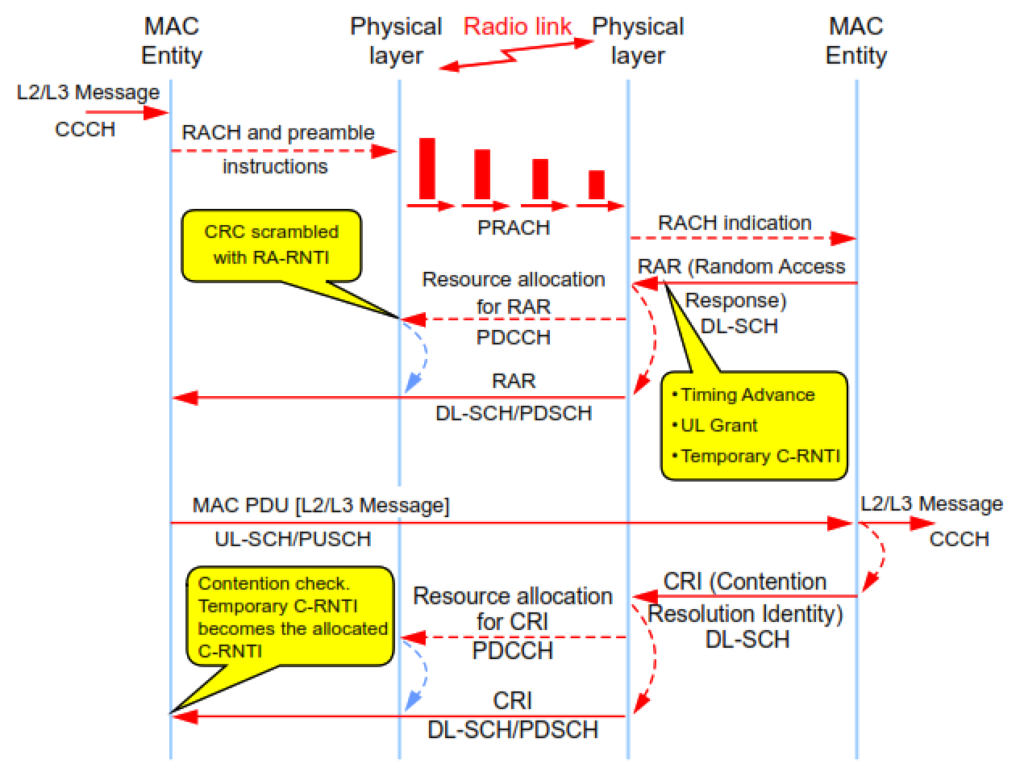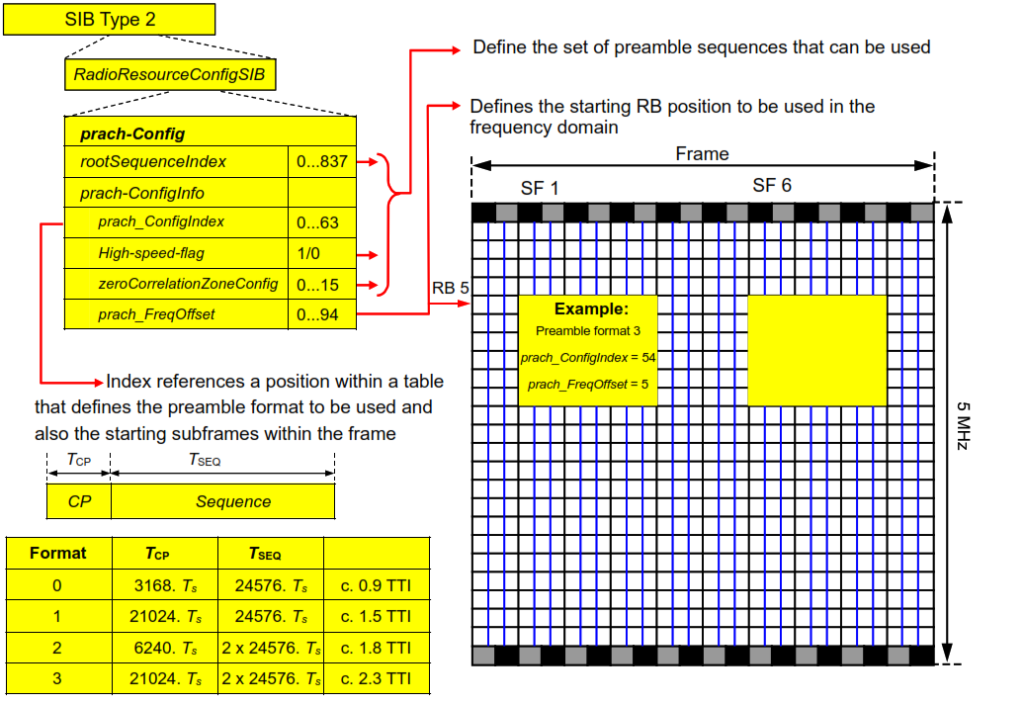The Random Access Procedure in LTE is an important process handled by the MAC (Medium Access Control) layer and the physical layer, enabling UEs (User Equipments) to establish initial communication with the eNodeB (evolved Node B). This procedure begins with the UE selecting a random access preamble from a range provided in the system information broadcast by the eNodeB. Following this, the UE checks the Broadcast Control Channel (BCCH) to determine the current LTE PRACH (Physical Random Access Channel) configuration, which includes details about the location and timing of PRACH resources within uplink subframes.

Once the PRACH configuration is understood, the UE calculates its initial transmit power using open loop power control, which involves setting the initial transmit power, determining the maximum transmit power, and planning power step increments for potential retransmissions. The UE also identifies contention management parameters from the system information, which are essential for handling scenarios where multiple UEs may choose the same preamble. After these preparations, the UE transmits its selected preamble on the PRACH and waits for a specified period for a response from the eNodeB. If no response is received within this period, the UE will back off, increase its transmit power, and retry the transmission.
Upon receiving a preamble, the eNodeB calculates the necessary power adjustment and timing advance parameters for the UE, based on the received signal’s strength and delay. The eNodeB then schedules an uplink capacity grant via the PDCCH (Physical Downlink Control Channel), allowing the UE to send its initial layer 3 message, typically an RRC (Radio Resource Control) Connection Request. If needed, the eNodeB assigns a Temporary Cell Radio Network Temporary Identifier (Temporary C-RNTI) to the UE for ongoing communication until a permanent identifier is assigned.
Following the transmission of the initial layer 3 message, the eNodeB reflects this message back to the UE in a subsequent downlink scheduled resource. This step is crucial for unambiguous contention resolution, ensuring that the UE’s transmission was successful and that no conflicts with other UEs occurred. Once contention is resolved, the UE may receive further resource allocations for additional signaling or traffic exchange, which are addressed to its assigned C-RNTI. This structured process ensures reliable initial communication and uplink synchronization between the UE and the eNodeB, laying the groundwork for continued network interaction and service delivery.
Resource Allocation for PRACH.
In LTE, resource allocation for the Physical Random Access Channel (PRACH) is designed to offer significant flexibility, enabling the network to accommodate various coverage scenarios. The PRACH is used by UEs (User Equipment) to send random access preambles to the eNodeB (evolved Node B) as part of the initial connection procedure or when re-establishing a connection. The random access preamble is transmitted in a specifically allocated PRACH timeslot, which varies depending on the preamble format.

The PRACH timeslot duration can correspond to one, two, or three subframe periods, depending on the preamble format chosen. LTE defines several preamble formats (types 0, 1, 2, and 3), each designed to cater to different coverage requirements by varying the lengths of the Cyclic Prefix (CP), the preamble sequence itself, and the Guard Time (GT). These variations allow the network to optimize the use of PRACH resources based on the specific deployment scenario, whether it be urban, suburban, or rural environments, which may have differing cell sizes and propagation delays.
PRACH timeslots are allocated with a regular repetition period known as the PRACH burst period, which can range from fractions of a frame to multiples of a frame. In a typical example with a 5 MHz bandwidth, a 10 ms PRACH burst period might be used, which corresponds to a frame in LTE. In this scenario, Format 0 preambles might be employed, which are generally suitable for smaller cell sizes with shorter propagation delays.
While more than one PRACH timeslot can be allocated simultaneously, doing so increases the processing load on the eNodeB, as it must manage multiple incoming preambles and potentially conflicting requests from UEs. Despite this, the system allows the eNodeB to schedule PUSCH (Physical Uplink Shared Channel) resources at the same time and frequency as a PRACH timeslot. This dual use of resources maximizes the efficiency of the available uplink spectrum but requires careful management to avoid interference between the PRACH and PUSCH transmissions.
PRACH Parameter Optimization & Configuration.
The configuration of PRACH resources in the uplink is primarily defined within System Information Block Type 2 (SIB2), which is broadcast by the eNodeB (evolved Node B). These parameters form part of the information element known as RadioResourceConfigSIB, and they outline how the PRACH resources are to be utilized.

The PRACH preamble sequences are derived from a set of Zadoff-Chu sequences, a type of complex-valued sequence with excellent correlation properties, which make them ideal for use in random access procedures. Each cell can have up to 64 distinct preamble sequences available, ensuring that multiple UEs can initiate random access without significant risk of collision.
For normal LTE operation, there are four preamble sequence formats, which are used to accommodate different coverage scenarios and cell sizes. The format that a cell will use is indicated to the UEs through an index that references a table specified in the LTE standards documentation. This table not only specifies the format but also identifies which subframes within a radio frame may be used as the starting point for the transmission of a PRACH preamble.
The minimum configuration allows for just one starting point, typically available only in even-numbered frames, which limits when the PRACH can be transmitted. On the other hand, the maximum configuration provides up to five starting points per frame, offering greater flexibility and reducing the potential for random access delays.
Additionally, SIB2 includes a parameter that specifies the starting frequency index for PRACH allocation. This parameter indicates the lowest Resource Block (RB) index that can be used for PRACH. The PRACH allocation in the frequency domain is always for six RBs, ensuring a fixed bandwidth allocation for random access regardless of the overall system bandwidth.
PRACH Procedure Control.
The PRACH (Physical Random Access Channel) procedure in LTE is controlled by several parameters defined within the RadioResourceConfigSIB information element, part of the System Information Block Type 2 (SIB2). These parameters govern how UEs (User Equipments) transmit preambles to initiate communication with the network.

Once the UE identifies the set of available preamble sequences on a cell, it must select one to use for the random access procedure. Optionally, the available preambles can be divided into two groups: Group A and Group B. The decision to use Group B preambles is influenced by two thresholds. The first threshold is related to the size of the layer 3 message that the UE will transmit after receiving a response. The second threshold concerns the required power offset between the power used for the preamble and the power needed for the subsequent layer 3 message transmission. If both thresholds are met, the UE selects a preamble from Group B; otherwise, it defaults to a preamble from Group A.
The UE then selects a starting frame and Resource Block (RB) from the set designated for PRACH. The transmission sequence is governed by four key parameters within the RadioResourceConfigSIB. The UE begins by calculating an initial transmission power based on the configured power control parameters. This initial power level is used for the first transmission of the preamble sequence.
After transmitting the preamble sequence, the UE monitors the PDCCH (Physical Downlink Control Channel) for a Random Access Response (RAR). The RAR is identified by an RA-RNTI (Random Access-Radio Network Temporary Identifier), which is linked to the specific preamble transmission. The UE continues to monitor the PDCCH for a response within a timeframe defined by the parameter ra-ResponseWindowSize. If no RAR with the corresponding RA-RNTI is received within this window, the UE will attempt a retransmission, increasing the power level incrementally.

This process of retransmission continues until the maximum number of retransmissions, specified by the parameter preambleTransMax, is reached. If the UE fails to receive a RAR after the maximum number of retransmissions, the PRACH procedure is considered to have failed. The UE then reports this failure to higher protocol layers, which may trigger further actions, such as initiating a new random access attempt or taking alternative measures depending on the network’s configuration and the UE’s state.
This article what we explain above is about basics of PRACH, it’s role in MAC layer and physical layer, LTE PRACH preamble format, PRACH resource allocation, parameter optimization and configuration.